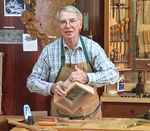We may receive a commission when you use our affiliate links. However, this does not impact our recommendations.
 A medium size machinist’s vise can be quite a handy tool in every shop and at every hobbyist/handyperson’s garage or studio. On top of helping us secure hardware and other small metal objects when drilling, sawing and filing, this vise can be very instrumental in providing assistance for shaping wooden objects. In my classroom, students use machinist’s vises (aka Bench vise) to clamp small wooden knives, carved animals and other small to medium size objects.
A medium size machinist’s vise can be quite a handy tool in every shop and at every hobbyist/handyperson’s garage or studio. On top of helping us secure hardware and other small metal objects when drilling, sawing and filing, this vise can be very instrumental in providing assistance for shaping wooden objects. In my classroom, students use machinist’s vises (aka Bench vise) to clamp small wooden knives, carved animals and other small to medium size objects.


A machinist’s vise equipped with wooden, rubber, cork or Homasote liners will arrest and secure the objects even better and will protect the work-pieces from being damaged by the hard steel jaws. Cutting the liner jaws on the band saw is very easy. By tailor fitting the shape of the liner to match the specific design of the vise and its mechanism, we can ensure that the liner jaws will stay put and not fall off every time we open the vise.

Homasote (a dense pulp board) is a great material to make soft jaws from.

I recently made such jaws for a new Yost vise that we purchased on Amazon. After receiving the vise, I disconnected the moving jaw by turning the acme screw all the way to the left. Then I measured and incorporated into my design all the essentials, such as the diameter of the screw and the dimension of the vise’s rectangular steel bar. Then I took a piece of scrap wood and drilled the hole for the screw first, followed by a quick visit to the band saw to cut the rectangular notch for the bar.

After unscrewing the moving jaw out I measured the needed dimensions to make the jaws liners.


Now we have a fantastic vise that performs very well, not just with metal objects but also with wooden one.


To make our vises’ even more handy I mounted them on a wooden platform that can be held onto our benches’ woodworking vises. This allows us to pair the machinist vise with the specific student who needs it. So instead of a fixed location such as on a countertop, we are now able to shuffle the vises in the room. When building such platform, make sure to leave 1” (25mm) cantilever in front of the lower wooden cleat/bar of the platform. This will secure the vise and the platform from forward tilting. Another advice is to anchor the machinist’s vise base’ through the platform’s cleat/bar (using a lag bolt or a nut & bolt). This will provide a really strong base/vise connection.



Lastly, if you make the mounting platform wide and long, then with the help of two F or C clamps on each side of the platform, you will be able to clamp it down to other surfaces such as tabletop or counter top — in cases were a woodworkers vise is unavailable.

– Yoav Liberman
Here are some supplies and tools we find essential in our everyday work around the shop. We may receive a commission from sales referred by our links; however, we have carefully selected these products for their usefulness and quality.









